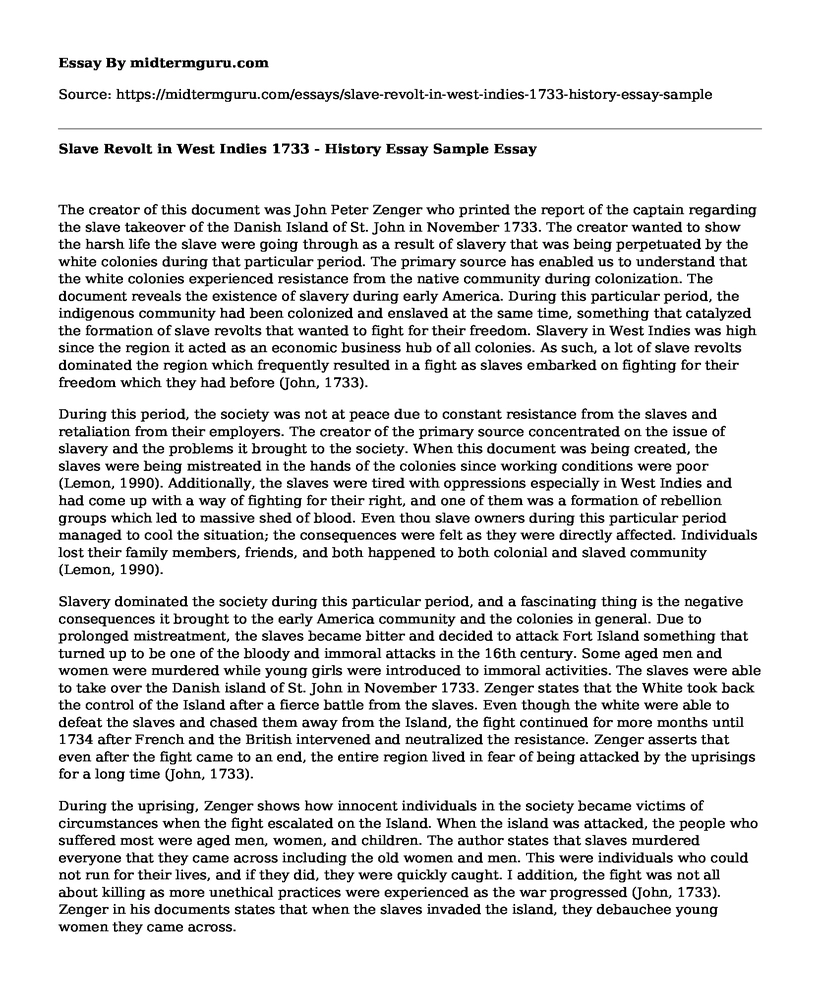The creator of this document was John Peter Zenger who printed the report of the captain regarding the slave takeover of the Danish Island of St. John in November 1733. The creator wanted to show the harsh life the slave were going through as a result of slavery that was being perpetuated by the white colonies during that particular period. The primary source has enabled us to understand that the white colonies experienced resistance from the native community during colonization. The document reveals the existence of slavery during early America. During this particular period, the indigenous community had been colonized and enslaved at the same time, something that catalyzed the formation of slave revolts that wanted to fight for their freedom. Slavery in West Indies was high since the region it acted as an economic business hub of all colonies. As such, a lot of slave revolts dominated the region which frequently resulted in a fight as slaves embarked on fighting for their freedom which they had before (John, 1733).
During this period, the society was not at peace due to constant resistance from the slaves and retaliation from their employers. The creator of the primary source concentrated on the issue of slavery and the problems it brought to the society. When this document was being created, the slaves were being mistreated in the hands of the colonies since working conditions were poor (Lemon, 1990). Additionally, the slaves were tired with oppressions especially in West Indies and had come up with a way of fighting for their right, and one of them was a formation of rebellion groups which led to massive shed of blood. Even thou slave owners during this particular period managed to cool the situation; the consequences were felt as they were directly affected. Individuals lost their family members, friends, and both happened to both colonial and slaved community (Lemon, 1990).
Slavery dominated the society during this particular period, and a fascinating thing is the negative consequences it brought to the early America community and the colonies in general. Due to prolonged mistreatment, the slaves became bitter and decided to attack Fort Island something that turned up to be one of the bloody and immoral attacks in the 16th century. Some aged men and women were murdered while young girls were introduced to immoral activities. The slaves were able to take over the Danish island of St. John in November 1733. Zenger states that the White took back the control of the Island after a fierce battle from the slaves. Even though the white were able to defeat the slaves and chased them away from the Island, the fight continued for more months until 1734 after French and the British intervened and neutralized the resistance. Zenger asserts that even after the fight came to an end, the entire region lived in fear of being attacked by the uprisings for a long time (John, 1733).
During the uprising, Zenger shows how innocent individuals in the society became victims of circumstances when the fight escalated on the Island. When the island was attacked, the people who suffered most were aged men, women, and children. The author states that slaves murdered everyone that they came across including the old women and men. This were individuals who could not run for their lives, and if they did, they were quickly caught. I addition, the fight was not all about killing as more unethical practices were experienced as the war progressed (John, 1733). Zenger in his documents states that when the slaves invaded the island, they debauchee young women they came across.
Conclusively, the essay has focused on the mistreatment that the slaves went through in the hands of their bosses during the sixteenth century. Their freedom in their lands was limited, and they could not freely move. The essay has further focused on the negative consequences of war to the society as a lot of people lost their lives when a group of slaves attacked the White Settlers Island. Individuals were displaced from their homes when the fight become intense. However, the document had a far-reaching effect on the later generation as people has learned the significance of treating others equally in the society. We are all born equally and treating others as slaves since this even make the society more deadly as what happened in Zengers society where a lot of people lost their lives, a principal cause being slavery. Notably, the source played an essential role in the society as slavery reduced, even though it continued for one more century, it was later abolished as slaves used the same strategy of forming revolt group which turned to be bloody.
References
John Z. (1733). Slave Revolt in West Indies, New York: The Gilder Lehrman Institute of American History, https://www.gilderlehrman.org/history-by-era/thirteen-colonies/resources/slave-revolt-west-indies-1733
Lemon, J. T. (1990). Colonial America in the eighteenth century. North America: The Historical Geography of a Changing Continent, 121-46.
Cite this page
Slave Revolt in West Indies 1733 - History Essay Sample. (2021, Jun 03). Retrieved from https://midtermguru.com/essays/slave-revolt-in-west-indies-1733-history-essay-sample
If you are the original author of this essay and no longer wish to have it published on the midtermguru.com website, please click below to request its removal:
- History of Abraham Louis Breguet - Research Paper
- The Course of The World War 1 - Research Paper
- Compare and Contrast Essay on WW2 Countries
- A Critical Analysis of "The Evangelicals: The Struggle to Shape America" by Frances Fitzgerald
- Questions and Answers Essay on World War 2
- 1st WW: 20th Century's Seminal Catastrophe - Essay Sample
- The Cherokee Trail of Tears: Symbol of Callousness in American History - Essay Sample







